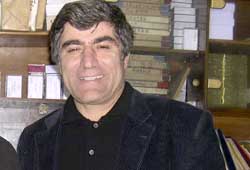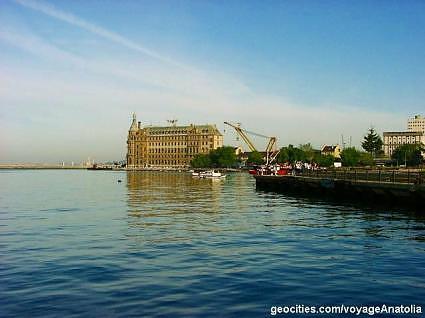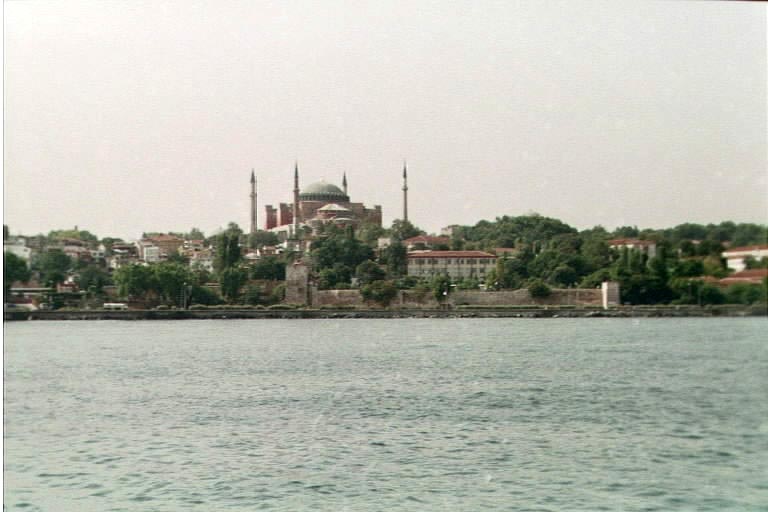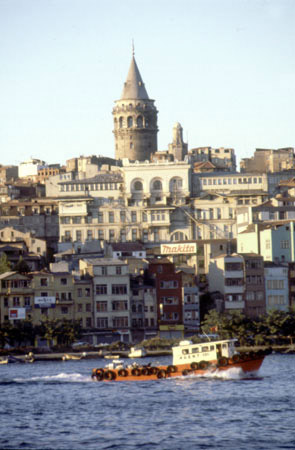İstanbul, January 23, 2007:
Hrant Dink Funeral March
 Turkey is said to be 99% Muslim. On Tuesday, January 23, 2007, in the
largest public demonstration in İstanbul in three decades, a
hundred thousand people turned out for the funeral of a Turkish Armenian
Christian.
Turkey is said to be 99% Muslim. On Tuesday, January 23, 2007, in the
largest public demonstration in İstanbul in three decades, a
hundred thousand people turned out for the funeral of a Turkish Armenian
Christian.
Hrant Dink was killed on Friday, Janary 19, 2007, outside the offices of Agos, the bilingual Turkish-Armenian newspaper that he had founded. On the following Tuesday, at 11.00, there was a ceremony at the Agos offices north of Taksim Square, beyond the military museum; then there was a procession to an Armenian church, eight kilometers to the south, on the Sea of Marmara, within the walls of old Constantinople.
 Ayşe and I travelled from Ankara to İstanbul on Monday night,
with three graduate students from our department and the spouse of one of
them. The six of us took two compartments (four beds each) on the
overnight train, arriving at Haydarpaşa
Terminal, on the shores of the Bosphorus, at 7.30 Tuesday morning.
Ayşe and I travelled from Ankara to İstanbul on Monday night,
with three graduate students from our department and the spouse of one of
them. The six of us took two compartments (four beds each) on the
overnight train, arriving at Haydarpaşa
Terminal, on the shores of the Bosphorus, at 7.30 Tuesday morning.
 At the ferry terminal, Arabic lettering from Ottoman times remains on
some tiles. From the boat itself, one sees the Hagia Sophia
church/mosque/museum where it has stood for fourteen centuries. But the
boat took us to the side of the Golden Horn that is opposite the old
city. We walked up the hill past the Galata Tower, from which the
Genoese could watch as Sultan Mehmet besieged and ultimately conquered
the city in 1453.
At the ferry terminal, Arabic lettering from Ottoman times remains on
some tiles. From the boat itself, one sees the Hagia Sophia
church/mosque/museum where it has stood for fourteen centuries. But the
boat took us to the side of the Golden Horn that is opposite the old
city. We walked up the hill past the Galata Tower, from which the
Genoese could watch as Sultan Mehmet besieged and ultimately conquered
the city in 1453.
 Near Taksim Square we had breakfast before continuing on to
the Agos offices. The way was along a six-lane road through
the city. We would later be marching back along the road.
Meanwhile, it was already closed to cars. Most of the
pedestrian traffic was headed in our direction.
Near Taksim Square we had breakfast before continuing on to
the Agos offices. The way was along a six-lane road through
the city. We would later be marching back along the road.
Meanwhile, it was already closed to cars. Most of the
pedestrian traffic was headed in our direction.
The block with the Agos offices was barricaded by police. We had to go around on side streets and get searched before entering the gathering place. My backpack was glanced in, my volume of Gibbon leafed through briefly. We joined the crowds.
Music played. People spoke, including Hrant Dink's widow Rakel, but we were too far away to hear properly. Her speech in English translation is now available. [Bianet link updated May 22, 2018.] At the end of the march, we met up with a colleague from Ankara, who had come to Istanbul by bus; he had been near the podium, and he spoke well of Rakel Dink's words, especially:
People had been asked not to bring banners and chant slogans. Instead, placards were handed out, reading "We are all Hrant; we are all Armenians" (in Turkish, Kurdish, and perhaps Armenian, albeit in Latin letters).Whatever would be the age of the murderers, 17 or 27, I know that they were born babies once. Without questioning the darkness that created murderers from those babies, there's nothing to do, my brothers and sisters.
People around us did nonetheless shout slogans. There was not much else to do, since we could not hear the official speakers properly. The main slogan was
Later somebody turned it into:Up with the brotherhood of peoples!
Here "up with" could be "long live", or the French vive: the Turkish is simply the third-person imperative form of "live".Kurd, Turk, Armenian: up with the brotherhood of peoples!
Another popular slogan was, "Shoulder to shoulder against fascism!" As we waited to march, we could see that some people were looking to the left as they chanted. When we moved, we could see that they were looking towards offices belonging to the Nationalist Movement Party.
We took two-and-a-half hours to reach the Sea.
The last big march in Istanbul was Bloody May Day, 1977, when hundreds of thousands of people gathered; they were shot at from surrounding buildings, and some were killed. The September 12 military coup came three years later.
 As we marched on Tuesday, we could see gunmen on rooftops looking down on
us. They wore uniforms. Some of them stood atop the aqueduct at
Saraçhane as we passed beneath.
As we marched on Tuesday, we could see gunmen on rooftops looking down on
us. They wore uniforms. Some of them stood atop the aqueduct at
Saraçhane as we passed beneath.
Ayşe was confident that nobody would shoot at a funeral procession. On the other hand, in his last article before he was killed, Hrant Dink compared himself to a pigeon, always looking around nervously; he said that in Turkey, one didn't disturb pigeons.
Some newspapers said we were tens of thousands of marchers. This is as much as I could estimate from what I could see. But I could never see the beginning or the end of the march, though the hilliness of the terrain made it possible sometimes to see quite far. Other newspapers gave our numbers at over a hundred thousand. It is possible. The crowd was said to take up four kilometers of the six-lane road.
Back in Ankara, a friend asked us: where were all of the Turkish women who wear Islamic headscarves? We didn't see any of them marching with us. We saw some watching from the sidewalks. Most bystanders looked on stony-faced. Some clapped. At a hotel, little girls in ethnic costume stood on the steps and cheered.
We did notice two elderly women marching in white headscarves: but those scarves were worn in Kurdish fashion. Near the aqueduct, more Kurdish women in colorful dress came out and clapped and ululated. As we passed a construction site, men in hard hats joined the march, taking up the signs that said "We are all Armenian."
Some marchers gave voice to more militant slogans:
The last was shouted when we passed an office of the Nationalist Movement Party or the Great Union Party. Unfortunately my translations do not carry the musical chanting of the Turkish slogans:Government, resign!
Baykal and Tayyip are both fascists!
Fascist Turkish Republic, out of Kurdistan!
Behold a nest of fascists!
That's "Kurdish, Turkish, Armenian: let live the peoples' brotherhood"—"brother" is genderless in Turkish.Kürt, Türk, Ermeni!
Yaşasın,
Halkların
Kardeşliği!
Itinerant businessmen in the crowd sold simit and half-liter bottles of water. It was a sunny day, warm for January: near perfect for a tour of Istanbul.
The march was to end at a church; but we couldn't see the church, actually: we just gathered by the seashore. A speaker said we could go to the cemetery (just outside the old city walls) if we really wanted to, but there wouldn't be room for everybody, so why didn't we just say goodbye to Hrant where we were. The hearse drove by slowly, covered with carnations. People threw more flowers as the hearse passed. There was also a procession of well-dressed people who (I suppose) had actually attended the church service. The Prime Minister had been "too busy" to attend, though one or two of his ministers went. I do not know why the President did not attend.
We caught a fast ferry at the adjacent terminal, along with the throngs of marchers who lived on the Asian side of the Bosphorus. From Kadıköy, we took a taxi to the Harem bus terminal and found seats on a 17.15 bus. We were back in Ankara 24 hours after we had left it.
Note: The photos here were found on the web and are linked to their sources.

